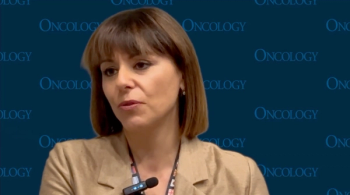
- ONCOLOGY Vol 13 No 3
- Volume 13
- Issue 3
Autologous Bone Marrow Transplantation Following Histologic Transformation of Indolent B-Cell Non-Hodgkin’s Lymphoma
Transformation from indolent B-cell non-Hodgkin's lymphoma (NHL) to a more aggressive histology occurs frequently in the natural history of these diseases, and is generally associated with a poor prognosis. Histologic conversion occurs in 25%-80% of patients with follicular NHL, but is less frequently seen in patients with chronic lymphocytic leukemia (CLL) or small lymphocytic lymphoma (SLL), reported in 3%-10% of patients. Between December 1982 and August 1997, 27 patients (14 male, 13 female) with a history of indolent B-cell NHL/CLL that had transformed to diffuse large B-cell lymphoma (DLCL) underwent autologous bone marrow transplantation (BMT). All patients were previously treated for indolent NHL/CLL with a median of threeprior therapies, and were similar with respect to whether transformation occurred early (< 18 months from diagnosis) or late.
Transformation from indolent B-cell non-Hodgkin's lymphoma (NHL) to a more aggressive histology occurs frequently in the natural history of these diseases, and is generally associated with a poor prognosis. Histologic conversion occurs in 25%-80% of patients with follicular NHL, but is less frequently seen in patients with chronic lymphocytic leukemia (CLL) or small lymphocytic lymphoma (SLL), reported in 3%-10% of patients. Between December 1982 and August 1997, 27 patients (14 male, 13 female) with a history of indolent B-cell NHL/CLL that had transformed to diffuse large B-cell lymphoma (DLCL) underwent autologous bone marrow transplantation (BMT). All patients were previously treated for indolent NHL/CLL with a median of threeprior therapies, and were similar with respect to whether transformation occurred early (< 18 months from diagnosis) or late.
These patients were uniformly treated with high-dose cyclophosphamide (Cytoxan, Neosar)/total-body irradiation and antiB-cell monoclonal antibodypurged autologous BMT. The median age of the patients was 44 years (range, 29-58 years). The histologies of these patients at diagnosis included 15 with follicular center cell grade I, 6 with follicular center cell grade II, and 6 with CLL/SLL. The median time from diagnosis to transformation was 35 months (range, 6-184 months). At bone marrow harvest, 12 patients were in complete response (CR), and 15 patients were in good partial response (PR) following conventional therapy. The median time from transformation to autologous BMT was 9 months (range, 2-41 months).
Following high-dose therapy, there were no acute in-hospital deaths. The median disease-free survival (DFS) and median overall survival (OS) durations following autologous BMT are 57 and 108 months, respectively. The 5-year DFS and OS rates are 46% and 58%, respectively. Eleven patients have relapsed, and 9 of these patients have died. Histology at the time of relapse was available in seven patients, and in all cases remained DLCL. Of the remaining 16 patients, 4 have developed secondary acute myelogenous leukemia (AML) or myelodysplastic syndrome (MDS) and all 4 have died, 2 following allogeneic BMT. Twelve patients are alive and free of disease, six more than 5 years after autologous BMT.
There was no significant difference in DFS or OS for the patients who were in CR or PR at autologous BMT. There was also no difference in DFS or OS between the 6 patients with a history of CLL/SLL and the 21 with a history of follicular lymphoma. However, patients who transformed within 18 months of diagnosis had a significantly better OS after autologous BMT than those who transformed later (P = .02).
CONCLUSION: This study demonstrates that a subset of patients with histologic transformation can experience prolonged DFS and OS following autologous BMT. In addition, patients who transform early in the course of their disease may respond particularly well to aggressive therapy.
Articles in this issue
almost 27 years ago
WHO Declares Lymphatic Mapping to Be the Standard of Care for Melanomaalmost 27 years ago
Navelbine Increased Elderly Lung Cancer Patients’ Survivalalmost 27 years ago
Consensus Statement on Prevention and Early Diagnosis of Lung CancerNewsletter
Stay up to date on recent advances in the multidisciplinary approach to cancer.

















































































